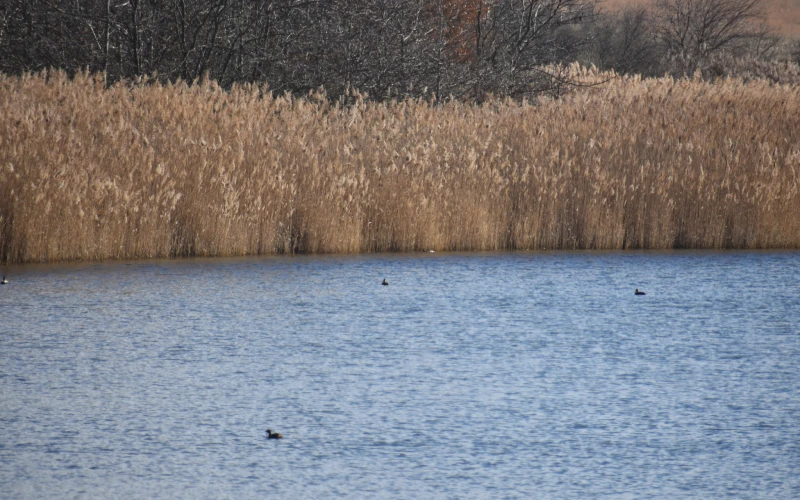Invasive Phragmites
Description
Invasive Phragmites is a tall perennial grass from Eurasia that has become one of the most destructive invasive plants in Central Canada including Ontario,Quebec and other parts of North America. Its introduction method to the continent remains unclear, but its presence has had devastating impacts on Canada’s ecosystems for decades. It aggressively outcompetes native species by rapidly spreading, releasing toxins that inhibit the growth of surrounding plants, and can survive in both wet and relatively dry conditions due to its long root system [1].

© Jared Gorrell via iNaturalist.org, used under CC BY NC
Habitat
This invasive reed prefers standing water but can also thrive in drier areas thanks to its extensive root system. It is commonly found in vegetated ponds, streams, pools, and along roadsides, often in populated urban or suburban areas.
Identifying Features
Native phragmites and its invasive counterpart can be hard to distinguish, especially in northern populations where invasive phragmites doesn’t grow as tall. It should be noted that native phragmites have more reddish-brown stems, yellow-green leaves and smaller, sparser seedheads.
A native Phragmites stand (left) and an invasive Phragmites stand (right).
Note the varied vegetation and lower density of native Phragmites stalks on the left and the taller, higher density invasive Phragmites stalks on the right. Native stand photo courtesy of Erin Sanders, MNR. Invasive stand photo courtesy of Janice Gilbert, MNR
Impacts
Invasive Phragmites poses several threats including:
Propagation
Stolons and Rhizomes
Invasive Phragmites primarily reproduces through its stolons (horizontal above-ground stems) and rhizomes (horizontal underground stems), allowing it to rapidly expand and form dense stands. This vegetative reproduction enables the plant to create vast networks of clones whichsignificantly enhances its ability to dominate landscapes. Fragments of the rhizomes can be broken off during storms and be washed away, propagating new stands in previously uninfested areas.
Underground Biomass
A substantial portion of the plant’s biomass is located underground in the form of rhizomes. This extensive underground system not only supports the aggressive spread of Phragmites but also makes it challenging to eradicate. Management efforts must address this below-ground component to be effective.
Seed Production
Seed Viability
While Phragmites can also reproduce sexually by producing seeds, the viability of these seeds is relatively low compared to itsreproduction success via rhizomes. However, the ability to produce seeds adds an additional layer of dispersal, potentially enabling the plant to colonize new areas.
Seed Head Capacity
Each seed head of invasive Phragmites is capable of containing up to 2,000 seeds. Despite the low viability, the sheer number of seeds produced can facilitate the spread of Phragmites, especially in disturbed habitats.
What you can do
Prevention
Play Clean Go
To prevent the spread of invasive species, stay on designated trails, clean equipment, vehicles and clothing after visiting infested areas, and dispose of plant material properly.
Clean Drain Dry
Inspect and remove any plant parts from watercrafts after leaving the water to prevent the spread of phragmites to new areas and waterbodies.
Physical Removal
There are various ways to manage phragmites that include mechanical removals (cutting, digging etc.) and chemical (herbicides, etc.). Further information on these methods can be found through the Ontario Invasive Plant Council best management practices.
Spread Awareness
Spread awareness about the ecological risks posed by invasive Phragmites and encourage responsible practices in your community.
Reporting
Report sightings of invasive Phragmites to local environmental agencies or invasive species hotlines. Visit www.reportcanadainvasives.ca
More information
Ontario Phragmites Fact Sheet
https://www.ontario.ca/page/phragmites-fact-sheet
Government of BC Invasive Species Alert for European Common Reed
https://www2.gov.bc.ca/assets/gov/environment/plants-animals-and-ecosystems/invasive-species/alerts/phragmites_weed_alert.pdf
Ontario’s Best Management Practices for Invasive Phragmites
https://www.ontarioinvasiveplants.ca/wp-content/uploads/2021/05/OIPC_BMP_Phragmites_April302021_D10_WEB.pdf
- Kerrie L. Wilcox, Scott A. Petrie, Laurie A. Maynard, Shawn W. Meyer, Historical Distribution and Abundance of Phragmites australis at Long Point, Lake Erie, Ontario, Journal of Great Lakes Research, Volume 29, Issue 4,2003, Pages 664-680,ISSN 0380-1330, https://doi.org/10.1016/S0380-1330(03)70469-9.
2. 2, Krzton-Presson, Amy, et al. “Effects of Phragmites Management on the Ecology of a Wetland.” Northeastern Naturalist, vol. 25, no. 3, 2018, pp. 418–36. JSTOR, https://www.jstor.org/stable/26577805. Accessed 21 Mar. 2024.